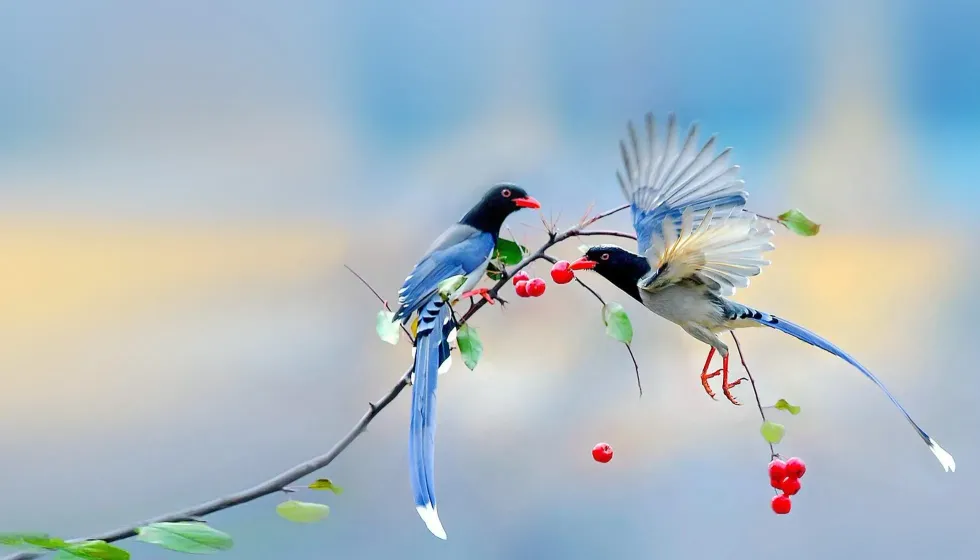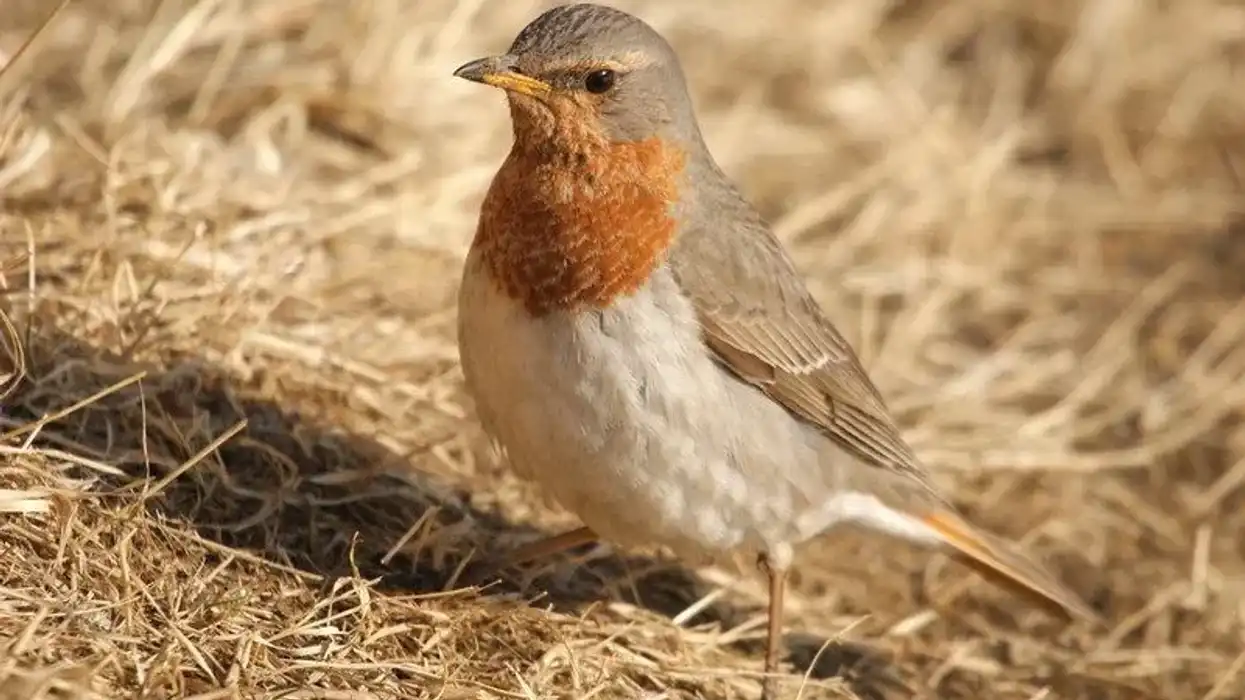There are 17 species of magpies in the world. The world's oldest fossil of a magpie was discovered in Queensland. They were named magpies primarily for the fact that they consume almost everything - they are omnivores. The red-billed blue magpie (Urocissa erythroryncha) is one among the same family and native to the Indian Subcontinent.
The red-billed blue magpie (Urocissa erythroryncha) is a colorful bird known for having one of the longest tails in birds. The red-billed blue magpie (Urocissa erythroryncha) has a high-pitched whistle and is an active bird that is intelligent.
The red-billed blue magpie (Urocissa erythroryncha) is classified as Least Concern and does not have any particular threats.
These birds are seldom seen near human dwellings and predominantly reside in hilly or mountainous regions primarily due to the ground they live in. The red-billed blue magpie (Urocissa erythroryncha) is also seen near trees and ground areas close to forest cover and consumes a wide range of food including food such as invertebrates and fruits.
This article will explore some fun and interesting facts about the red-billed blue magpie (Urocissa erythroryncha). For more such relatable content, check out these summer tanager and hyacinth macaw facts.
Red-Billed Blue Magpie Interesting Facts
What type of animal is a red-billed blue magpie?
The blue magpie (red-billed), Urocissa erythroryncha, is a bird animal and is endemic to the Indian subcontinent.
What class of animal does a red-billed blue magpie belong to?
The classification of red-billed blue magpie is Aves since it is a type of bird that belongs to the family Corvidae and genus Urocissa.
How many red-billed blue magpies are there in the world?
The exact population of these birds is not evaluated. The blue magpie (red-billed) population globally has increased since the second world war. The blue magpie (red-billed) feeds on small invertebrates other small animals and fruit and some seeds.
Where does a red-billed blue magpie live?
These endemic birds are native to India and are seen in the western Himalayas eastwards to Myanmar. They are also found in parts of southeast Asia including Beijing, Hong Kong, and China. They live in the forested areas, trees and enormous bushes, evergreen forest, and scrub. The blue magpie (red-billed) builds relatively shallow nests.
What is a red-billed blue magpie's habitat?
Their habitat is usually in a wide range as long as they get invertebrates other small animals to feed on as well as fruit and some seeds. The blue magpie (red-billed) bird occurs in a wide range of forests and woodlands and in other similar habitats.
The blue magpie (red-billed) is also seen in evergreen forest sand scrub in predominantly hilly or mountainous countries.
They build relatively shallow nests as compared to other species of birds. Blue magpie red-billed birds are seen in the western Himalayas eastwards and other regions as well and other parts in Beijing and Hong Kong.
Who do red-billed blue magpies live with?
The red-billed magpie (Urocissa erythroryncha) is often seen in groups hunting for small animals and fruit to feed on. Food such as invertebrates too is consumed. They consume a wide range of food including small animals and fruit. Food is sought by following species like foxes and others to feed on the remains.
How long does a red-billed blue magpie live?
Red-billed blue magpie (Urocissa erythrorhyncha) exact lifespan is not evaluated however, magpies are estimated to live for 25-30 years. The oldest recorded magpie lived 21 years.
How do they reproduce?
Male and female Urocissa erythrorhyncha reproduce sexually and are monogamous birds. The red-billed blue magpie bird's breeding season is from April to June.
It builds nests with leftover material in bushes or trees. The red-billed blue magpie has multiple courtship displays as well while mating including the short buoyant flight.
They lay five to seven nests of eggs per clutch and hatch out after 21-22 days in trees and large shrubs. The young ones fledge after 27 days where the females incubate the egg and both parents feed the young in trees and large shrubs.
What is their conservation status?
The red-billed magpie (Urocissa erythrorhyncha) conservation status is listed as Least Concern species by the International Union For Conservation Of Nature (IUCN).
Red-Billed Blue Magpie Fun Facts
What do red-billed blue magpies look like?
Physical characteristics of red-billed blue magpie consist of a broad white tip at the end of their long tail. They have a crown on the shoulders as well as spotting. Their long tail is an intense blue with a white tip.
Their long tail is bright and instantly captivates the eye. Their underparts are a royal blue. The blue magpie (red bill) legs and feet, even the ring around the eye, are vibrant tones of bright orange-reddish.
The red-billed blue magpie has spotting on the crown region. The bird's eye and area up to the neck is dim in color including their head, neck and breast are black with a bluish tinge. The breast is black in both males and females. Their shoulders and rump are a light blue. They are identified with the crow family.

How cute are they?
These species of birds are extremely beautiful and cute in appearance and feed on fruit and some seeds as well as invertebrates and other small animals. Red-billed magpies are intelligent and interactive birds although they might not be as accommodative as parrots however, blue magpies (red-billed) are equally welcoming and even recognize themselves in a mirror.
How do they communicate?
They are good communicators and communicate via both songs as well as calls. Calls are distinct. Vocal mimicry is evident in this species and its calls are varied with the type of information sent to each other. The blue magpie frequently exchange messages via high pitched whistle or the grating rattle.
How big is a red-billed blue magpie?
The red-billed blue magpie, related to the crow family, is 25.5-27 in (65-68 cm) long which is two times bigger than the azure winged magpie which is 12.2-13.8 in (31-35 cm).
How fast can a red-billed blue magpie fly?
The exact flight speed of billed blue magpie is not known however, the average magpie species fly at 20 mph (32.2 kph).
How much does a red-billed blue magpie weigh?
The red-billed blue magpies weigh 6.9-8.2 oz (196-232 g). The smallest species of magpies is called a peewit and weighs 0.5 lb (220 g).
What are the male and female names of the species?
The male and female of the species are not addressed differently. Males and females are similar in appearance but differ in reproductive functions.
What would you call a baby red-billed blue magpie?
A baby red-billed blue magpie could be referred to as a chick and is born without any feathers. It is completely dependent on its parents in the initial few weeks for shelter and food. An adult feeds on seeds. It robs nests of eggs to feed their young as well.
What do they eat?
This bird is primarily an insectivore and consumes insects like ants and other small animals, plants, and fruits as well. These species of birds forage for food throughout the day. These birds also consume plant seeds. This species of bird is known to rob other bird's nests and feeds on matter leftover from other animals.
Are they poisonous?
No, they are not poisonous or dangerous however, owing to the fact that they are a species of wild birds it's safe to observe them from a distance in shrubs in a relatively dense region.
Would they make a good pet?
You could visit the red-billed blue magpies zoo in the St Louis Zoo in the United States of America. Another place to see the red-billed blue magpies in Australia is the zoo and conservation centers.
Did you know...
Australian magpies are some of the most accomplished songbirds of Australia. Did you know that the Australian magpies are known to mimic human speech if they are in close proximity to humans?
Young magpies often move in groups and are referred to as parliament. They derive this name primarily for the reason that they arrive in groups, caw at each other, and looking stately. Isn't that amusing!
Are red-billed blue magpies endangered?
No, these species are not endangered however certain other species are. The species are classified as Least Concern species by the IUCN red list and reside near trees and shrubs in a relatively secluded place since they are territorial and also stay away from predators.
The parent species are responsible for protecting the eggs and also chicks since they are completely reliant on their parents. The red-billed blue magpie eradicated in Australia happened in order to deal with bird damage.
How do you identify a red-billed blue magpie?
Their bill is a bright orange-reddish color, they have a white tip and a bluish tail and a dark color on the crown the shoulders, and the neck region. Their upperparts are blue and the underparts are grayish to light in color.
These species occur in a broad range. They are easy to identify as long as you look closely.
A species native to the United States is the black-billed magpies and others species of magpies. If you are a birdwatcher or love birds and wish to see such species, visit a bird sanctuary, conservation center, or other such places in your region.
Here at Kidadl, we have carefully created lots of interesting family-friendly animal facts for everyone to discover! Learn more about some other birds from our palm warbler fun facts and Amazon parrot interesting facts pages.
You can even occupy yourself at home by coloring in one of our free printable red-billed blue magpie coloring pages.










